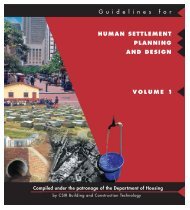POTHOLES: - CSIR
POTHOLES: - CSIR
POTHOLES: - CSIR
- No tags were found...
You also want an ePaper? Increase the reach of your titles
YUMPU automatically turns print PDFs into web optimized ePapers that Google loves.
Potholes that develop along the centre-line of theroad are frequently the result of poor sealing/bonding of joins between successive runsduring the sealing process. Water can enterthe pavement along these joins, weakeningthe material and forming potholes. Otherconstruction deficiencies (e.g. localised areasof poor compaction because they are too wetduring construction, material segregation, lackof bond between base and seal, etc.) canalso lead to potholes not directly relating to theseasonal moisture movements (Figure 25). Thewidth of the road and whether the shoulders aresealed can also affect the location of potholes.On narrower roads, the inner wheel paths inthe two directions may overlap, resulting in aneffective doubling of the load in this area andpossible development of potholes.Potholes between the centre-line and the outerwheel track, in the zone of moisture equilibrium,are generally the result of unsealed cracks, poorbonding between the base and seal, or localisedareas of poor construction or material quality.2.8 Non-labour-based repairThe majority of pothole repairs will normallybe undertaken using teams of road workers,usually with a mechanical compactor. However,when potholing becomes extensive or affectslong, linear sections of road (Figure 26), it maybe more effective to use a small recycler ormilling machine to remove the affected areaand replace the material with an appropriaterepair material. This process is not discussed inthis document and should follow conventionalrecycling or large repair procedures.Figure 26: Long, linear development of potholes, resulting from inappropriate layer materials23

















